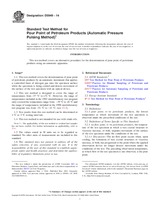Potřebujeme váš souhlas k využití jednotlivých dat, aby se vám mimo jiné mohly ukazovat informace týkající se vašich zájmů. Souhlas udělíte kliknutím na tlačítko „OK“.
ASTM D5949-14
Standard Test Method for Pour Point of Petroleum Products (Automatic Pressure Pulsing Method)
Automaticky přeložený název:
Standardní zkušební metoda pro Bod tuhnutí ropných produktů (automatické tlakové Impulzní metoda)
NORMA vydána dne 1.5.2014
Informace o normě:
Označení normy: ASTM D5949-14
Poznámka: NEPLATNÁ
Datum vydání normy: 1.5.2014
Kód zboží: NS-33160
Počet stran: 6
Přibližná hmotnost: 18 g (0.04 liber)
Země: Americká technická norma
Kategorie: Technické normy ASTM
Kategorie - podobné normy:
Anotace textu normy ASTM D5949-14 :
Keywords:
Peltier, petroleum products, pour point, pressure pulsing, thermoelectric, ICS Number Code 75.080 (Petroleum products in general)
Doplňující informace
| Significance and Use | ||||||||||
|
5.1 The pour point of a petroleum product is an index of the lowest temperature of its utility for certain applications. Flow characteristics, like pour point, can be critical for the correct operation of lubricating oil systems, fuel systems, and pipeline operations. 5.2 Petroleum blending operations require precise measurement of the pour point. 5.3 In most cases, this test method does not require the use of mechanical refrigeration apparatus (see 5.4 This test method yields a pour point in a format similar to Test Method D97/IP 15 when the 3 °C interval results are reported. 5.5 Test results from this test
method can be determined at either 1 °C or 3 °C intervals.
5.6 This test method has better repeatability and reproducibility relative to Test Method D97/IP 15 as measured in the 1992 and 1998 interlaboratory test programs.1.1 This test method covers the determination of pour point of petroleum products by an automatic instrument that applies a controlled burst of nitrogen gas onto the specimen surface while the specimen is being cooled and detects movement of the surface of the test specimen with an optical device. 1.2 This test method is designed to cover the range of temperatures from −57 °C to +51 °C. However, the range of temperatures included in the 1992 interlaboratory test program only covered the temperature range from −39 °C to +6 °C and the range of temperatures included in the 1998 interlaboratory test program was from −51 °C to −11 °C. (see 13.4). 1.3 Test results from this test method can be determined at 1 °C or 3 °C testing intervals. 1.4 This test method is not intended for use with crude oils. 1.5 The values stated in SI units
are to be regarded as standard. No other units of measurement are
included in this standard.
1.6 This standard does not purport to address all of the safety concerns, if any, associated with its use. It is the responsibility of the user of this standard to establish appropriate safety and health practices and determine the applicability of regulatory limitations prior to use. |
||||||||||
| 2. Referenced Documents | ||||||||||
|
Doporučujeme:
EviZak - všechny zákony včetně jejich evidence na jednom místě
Poskytování aktuálních informací o legislativních předpisech vyhlášených ve Sbírce zákonů od roku 1945.
Aktualizace 2x v měsíci !
Chcete vědět více informací? Podívejte se na tuto stránku.




 Cookies
Cookies
